LISA Pathfinder to conclude trailblazing mission
20 June 2017
After sixteen months of science operations, LISA Pathfinder will complete its mission on 30 June, having successfully demonstrated the technology to build ESA's future space observatory of gravitational waves.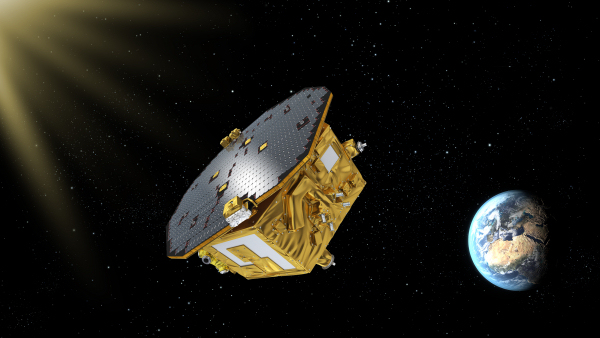 |
| LISA Pathfinder in space. Credit: ESA/C. Carreau |
Launched on 3 December 2015, ESA's LISA Pathfinder started its science mission in March 2016, shortly after the announcement of the first direct detection of gravitational waves – ripples in the fabric of spacetime.
Since then, with two more observations of gravitational wave signals from merging black holes obtained using ground-based experiments – the latest one announced this month – it is clear that gravitational-wave astronomy has become a reality.
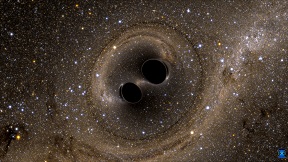 |
| Merging black holes. Credit: SXS |
Gravitational waves are produced by the acceleration of massive objects and can be generated by a wide range of cosmic phenomena, from supernova explosions to neutron star binaries spiralling around each other and pairs of merging black holes.
The signals detected so far have a frequency of around 100 Hz, corresponding to the coalescence of two stellar mass black holes, but gravitational waves span a much broader spectrum. To fully exploit this new window on the cosmos, it is crucial to be able to detect gravitational waves at low frequencies, between 0.1 mHz and 1 Hz, which are released by the mergers of the supermassive black holes sitting at the centre of galaxies – these waves can only be observed from space.
As LISA Pathfinder approaches the end of its successful technology demonstration mission, ESA's Science Programme Committee has selected today the Laser Interferometer Space Antenna (LISA) as the third large mission (L3) in ESA's Cosmic Vision plan. LISA is a space-based observatory of gravitational waves consisting of a constellation of three spacecraft, with launch planned for 2034.
In the LISA mission concept, six test masses will fly, two on each spacecraft. Each pair of test masses will be located at the end of the arm of the constellation, and will be linked to the others over millions of kilometres via lasers.
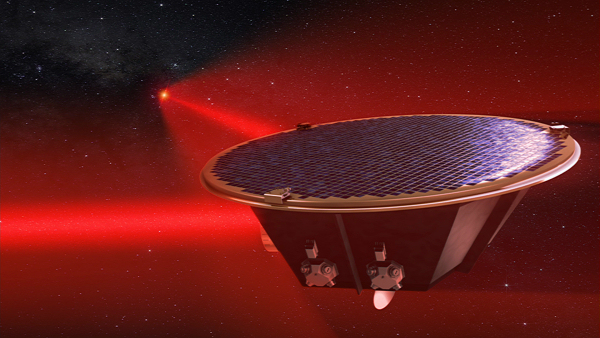 |
| LISA mission concept. Credit: AEI/Milde Marketing/Exozet |
The test masses must be placed in the most precise freefall that can be achieved, isolated from all external and internal forces except gravity, in order to measure any possible distortion caused by a passing gravitational wave. These waves affect the fabric of spacetime on the minuscule scale of millionths of a millionth of a metre over a distance of a million kilometres.
"The whole point of LISA Pathfinder was to validate the technology for LISA, which requires test masses to be kept motionless to unprecedented levels of accuracy," says Paul McNamara, LISA Pathfinder Project Scientist at ESA.
"This seemed so difficult and could not be tested on the ground, so we had to send the laboratory to space."
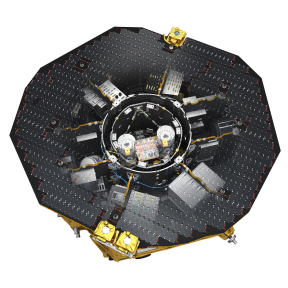 |
| Inside LISA Pathfinder. Credit: ESA/ATG medialab |
To this aim, LISA Pathfinder hosted two test masses, linked by a laser interferometer, at the core of one spacecraft, and employed several sets of micronewton thrusters to slightly shift the spacecraft and keep it centred around them. The mission demonstrated that it is indeed possible for the test masses to be virtually motionless with respect to each other, with a relative acceleration of only ten billionths of a billionth of Earth's gravity.
"With the astonishing success of LISA Pathfinder, we now know how to build a mission like LISA," says Stefano Vitale of University of Trento and INFN, Italy, Principal Investigator of the LISA Technology Package, the mission's core payload.
Exceeding the team's most optimistic expectations, the mission requirements were already reached within the first day of science operations – a testament to the very careful and thorough work done prior to launch. The following months were spent improving the performance of the experiment, gathering the all important knowledge and experience for a future gravitational-wave observatory.
"The system was built so well that the difference in the gravitational field coming from the satellite itself, at the two test mass positions, was essentially zero," says Paul. "This significantly reduced the forces we needed to apply to keep them stationary with respect to one other, and thus the overall noise of the experiment."
During the course of the mission, scientists and engineers perturbed the motion of the test masses in many different ways, monitoring their relative positions to unprecedented accuracy to estimate the origin of any deviation from their almost perfect freefall.
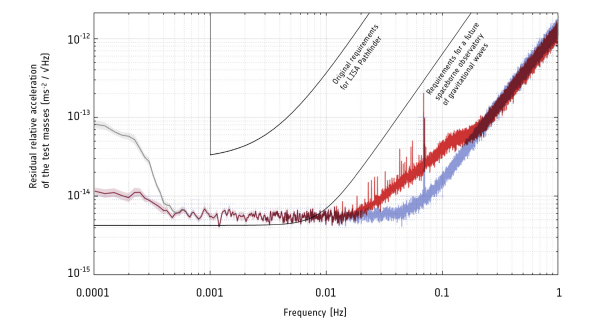 |
| LISA Pathfinder first results. Credit: ESA/LISA Pathfinder Collaboration |
The first results, published in June 2016 in Physical Review Letters, showed that LISA Pathfinder's precision at high frequencies (between 60 mHz and 1 Hz) had already surpassed the level required by a future gravitational-wave observatory by a factor of more than 100; at lower frequencies (1–60 mHz) the precision was also better than the LISA Pathfinder requirement, with the limiting factor being gas molecules bouncing off the test masses.
The latter effect has been observed to decrease steadily over the mission's lifetime as more molecules were vented into space. In addition, the team switched off many of the heaters on board in January 2017 to cool down the spacecraft, reducing the temperature from 22°C to 11°C – this also reduced the internal pressure in the enclosures of the test masses.
The spacecraft was operated at this lower temperature for several weeks, resulting in a further decrease of the residual noise on the motion of the test masses at frequencies between 1 and 60 mHz. In February, the team determined the noise in this frequency range to be lower than the requirements for a future gravitational-wave observatory by a factor of more than three.
"We have exceeded not only the requirements set for LISA Pathfinder, but also the accuracy required for LISA at all frequencies: we are definitely ready to take the next step," says Karsten Danzmann, director at the Max Planck Institute for Gravitational Physics, director of the Institute for Gravitational Physics of Leibniz Universität Hannover, Germany, Co-Principal Investigator of the LISA Technology Package, and lead proposer of LISA.
LISA Pathfinder has also achieved the most sensitive measurements of the perturbation to the freefall motion of the test masses caused by cosmic rays – electrically charged particles, like protons or electrons – that flow across our Galaxy. This result, published in April 2017 in Physical Review Letters, will be important not only for a future gravitational-wave observatory but also for other space-based experiments testing gravity and fundamental physics.
Beyond the original scope of the mission, LISA Pathfinder data have also been applied to investigate fundamental aspects of quantum physics, as reported in two papers published in Physical Review D [paper 1, paper 2]. Using measurements of the residual acceleration between the test masses, two independent groups of scientists have set the most stringent constraints to date on the 'wave function collapse' models. These models are used to explain the dichotomy between quantum effects, which are observed on microscopic scales, and the classical physics behaviour seen in the macroscopic world.
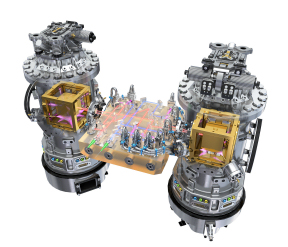 |
| The LISA Technology Package. Credit: ESA/ATG medialab |
This month – the mission's last month of operations – scientists and engineers have been conducting a series of tests to probe the thermal and optical properties of the vacuum enclosure where the test masses are hosted; other experiments are measuring the charging properties of the test masses, comparing them with similar measurements performed earlier in the mission to investigate how the system evolved with time.
Besides the LISA Technology Package, a European payload consisting of the test masses, inertial sensors, a laser interferometer, and cold-gas micronewton thrusters, the spacecraft also carries NASA's Disturbance Reduction System (DRS), an additional experiment with its own micronewton thrusters based on colloidal technology.
LISA Pathfinder operations were split between the two experiments. Both thruster technologies have now been validated and will benefit future space projects such as large space observatories, or missions involving multiple spacecraft flying in formation.
The mission will continue taking data until 30 June, with a final experiment that will be pushing the precision limits of the test mass grabbing and releasing mechanisms – something of great importance for LISA. Then, after a series of final operational tests, the last command will be sent on 18 July.
A preliminary de-orbiting manoeuvre was already performed in April, nudging the spacecraft away from its orbit around the first Sun-Earth Lagrange point, L1, and towards a long-term stable parking orbit around the Sun.
"While we are sad to part ways with the pioneering mission of LISA Pathfinder, the selection of LISA gives us a nice sense of continuity, and we are really looking forward to getting started with the early phases of this exciting new mission," says Oliver Jennrich, LISA Pathfinder Deputy Project Scientist, and Study Scientist at ESA for LISA.
Notes for Editors
LISA Pathfinder is an ESA mission with important contributions from its member states and NASA.
The LISA Technology Package payload has been delivered by several national funding agencies and ESA, in particular: Italy (ASI); Germany (DLR); the United Kingdom (UKSA); France (CNES); Spain (CDTI); Switzerland (SSO); and the Netherlands (SRON). LISA Pathfinder also carries the Disturbance Reduction System payload, provided by NASA.
Hypothesised by Albert Einstein a century ago, gravitational waves are oscillations in the fabric of spacetime, moving at the speed of light and caused by the acceleration of massive objects.
For further information, please contact:
Paul McNamara
LISA Pathfinder Project Scientist
European Space Agency
Tel: +31 71 565 8239
Email: paul.mcnamara![]() esa.int
esa.int
Oliver Jennrich
LISA Pathfinder Deputy Project Scientist
LISA Study Scientist
European Space Agency
Tel: +31 71 565 6074
Email: oliver.jennrich![]() esa.int
esa.int
Stefano Vitale
LISA Technology Package Principal Investigator
University of Trento and INFN, Italy
Tel: +39 046 128 1568
Email: stefano.vitale![]() unitn.it
unitn.it
Karsten Danzmann
LISA Technology Package Co-Principal Investigator
Max Planck Institute for Gravitational Physics
and Institute for Gravitational Physics of Leibniz Universität Hannover
Germany
Tel: +49-511-762 2356
Email: karsten.danzmann![]() aei.mpg.de
aei.mpg.de






